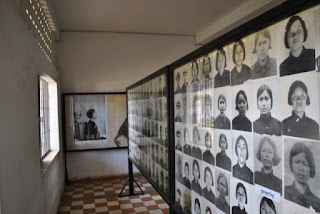We'll start out on a light note, cause this will get a bit dark.
Siem Reap was a blast! We got to see the wonders of Angkor during the day and hit pub street at night. Here we are on our last night in Siem Reap, with Lucie and Edgar (and another couple who joined us for a couple buckets):
We only spent a couple days in Phnom Penh. On our one full day we visited The Choeung Ek killing fields and the S 21 museum. Choeung Ek, 17km outside of Phnom Penh, was once a Chinese graveyard but is now known as the "killing fields", used by the Khmer Rouge between 1975-1979. Here they executed thousands (17,000 according to wikipedia).
This is a photo of one of the mass graves discovered after the Khmer Rouge rule ended. Almost 9,000 bodies have been found so far at the killing fields. Bones, teeth, and clothing are still found all over the grounds, washing up after the rainy seasons. The ground are full of mass graves. There is a memorial stupa when you first enter the field. Inside is a glass case with level after level of bones recovered from the many mass graves. On the lower levels are the skulls, separated by age and sex. It's a really haunting display.
This is called the "killing tree". Here, the KR killed children by throwing them against the tree. The killing fields were first discovered after the Khmer Rouge rule ended. People started coming back to Phnom Pen (they had been forced to the countryside by the KR) and walking past the fields they noticed the stench. One witness says the tree was covered in blood and brains when he found it. Bullets were too expensive so they chose to execute their victims with their hands. They used the tree for children and used tools such as machetes and hammers on the adults. This often caused a long and tortuous execution. They had loud speakers set up in the trees playing music to drown out the screams of their victims.
This is the Tuol Sleng Genocide Museum. It's a former school and was used as the S-21 security prison by the Khmer Rouge. Many of the people executed at the killing field were once prisoners here. The prison was used mainly for detaining and torturing "enemies" of the KR. Many were tortured for days and weeks until they confessed to outrageous allegations, such as being spies for the CIA or KBG. Once they signed confessions they were taken to be executed. Many prisoners were also forced to name their family and friends as associates so that the KR could arrest, torture, and execute more people. It's estimated about 20,000 prisoners were detained at S-21. Of these, 7 survived.
Before coming to Cambodia, I knew nothing of the events of this time. I can't believe all this happened just over 30 years ago and I've never heard of the Khmer Rouge until now. It's hard to believe it really happened, that such a mass genocide could have happened during our lifetimes. The Khmer Rouge case trials are currently taking place.
More on the Khmer Rouge from our good friends at Wikipedia: http://en.wikipedia.org/wiki/Khmer_rouge
victims of S-21





No comments:
Post a Comment